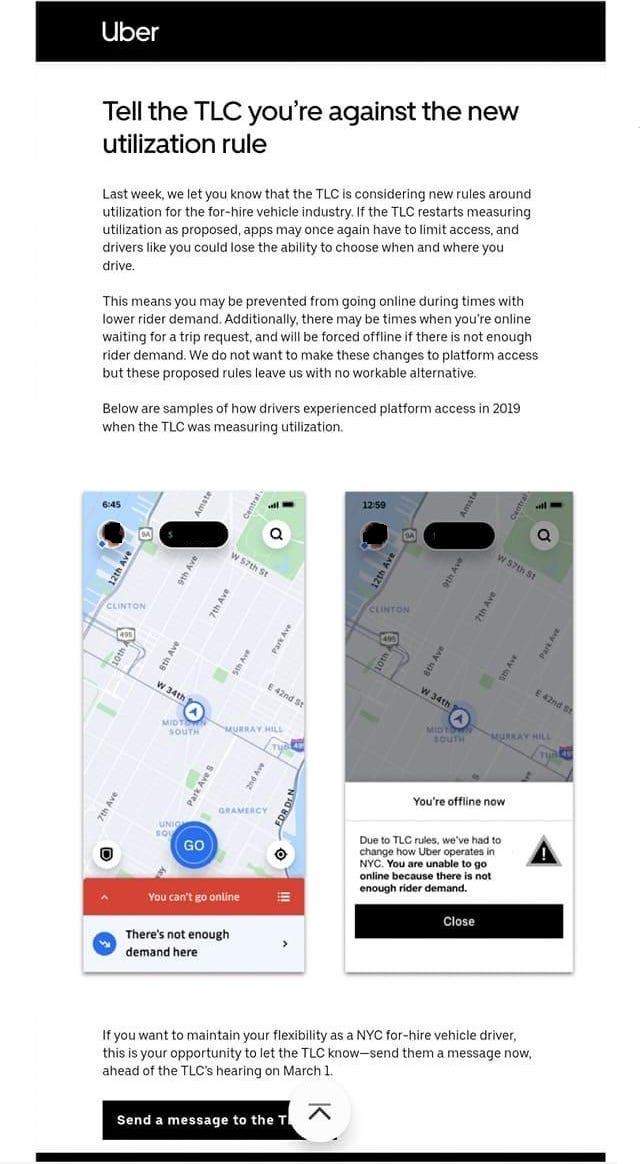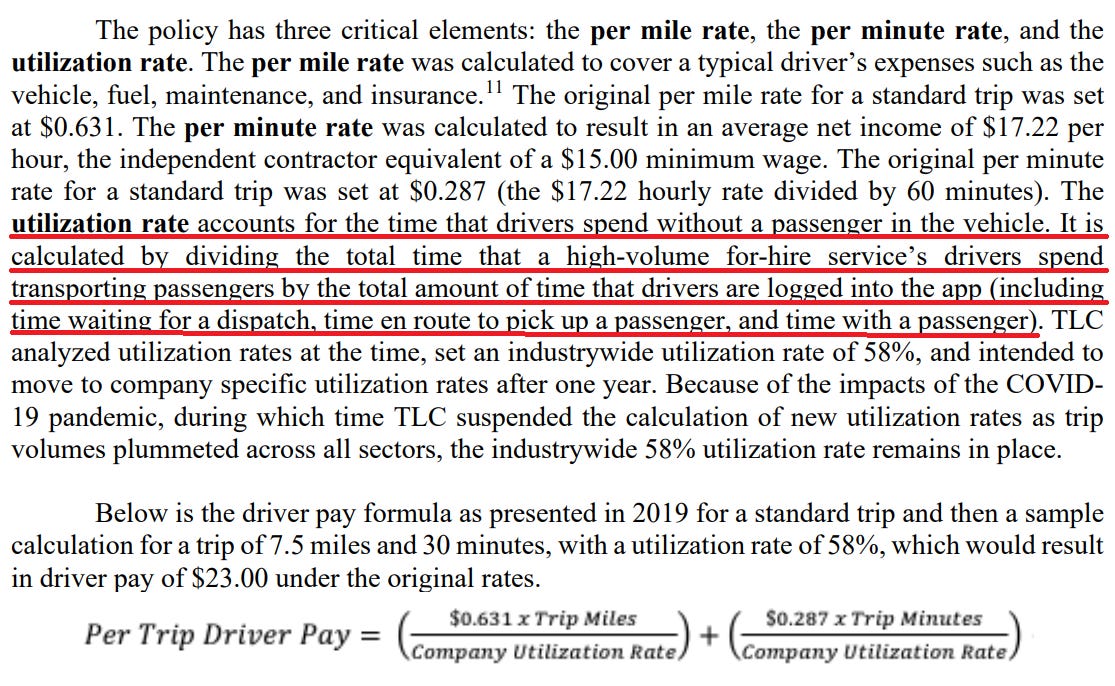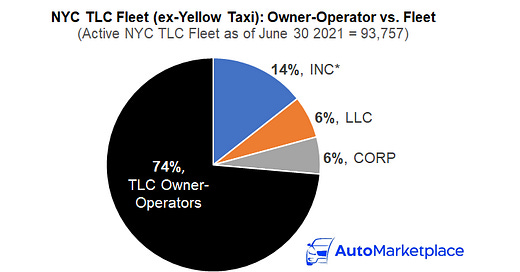

Discover more from AutoMarketplace
🔒 Uber NYC Lockout & Utilization Rate
Ahead of a March 1st TLC Commission hearing on driver pay, Uber warns reinstituting "utilization rate" calculation will lead to NYC driver "lockouts" & return of "planner". We explore what's going on
TLC wants to reinstitute “utilization rates” in its driver pay calculations
Uber warns that it will likely have to bring back its “planner” (a/k/a “lockouts”)
We explore the different dynamics at play
Recently, Uber has been sending messages to its NYC drivers, encouraging them to voice their concern(s) about NYC Taxi & Limousine Commission’s (TLC) proposal to reinstitute “utilization rates” related to the TLC Driver Minimum Pay calculation for high-volume for-hire service bases (i.e., Uber & Lyft).
Uber argues that being subject to a utilization rate requirement will likely force it to reinstitute the much hated pre-pandemic “Uber Planner”, or what many NYC TLC drivers referred to as “lockouts”.
An NYC TLC Commission meeting is set to take place on Wednesday, March 1st at 10am to discuss several topics related to NYC TLC driver pay, with utilization rates being a key discussion point. We’ll have more specifics on the March 1st meeting in an upcoming article, but wanted to specifically focus this piece on utilization rates and the potential for Uber NYC “lockouts” coming back.
Today, we are going to try to simply answer a few questions.
What is the utilization rate?
Why did the TLC create this measurement?
Why would it cause Uber to (re)introduce “lockouts”?
Utilization Rate, Per Mile, Per Minute
There are three key inputs the TLC uses when calculating the TLC Driver Minimum Pay Standard for high-volume for-hire services (currently only applicable to Uber & Lyft):
Per Mile Rate: Compensation for distance travelled. Estimates driver expenses, such as fuel, maintenance & insurance
Per Minute Rate: Compensation for time. Solves for “net wage” that’s benchmarked to New York State & City gross minimum wage rules
Utilization Rate: Essentially how busy a driver is kept. Time with a passenger(s) ➗ total hours “online” waiting for / travelling to a trip plus time with passenger(s)

The utilization rate, the TLC would likely argue, is a metric the regulator created to ensure the industry consisted of full-time & highly utilized commercially licensed drivers vs. part-time “rideshare” drivers. Given congestion concerns and how how lucrative (& regulated) NYC’s for-hire transportation had historically been, the TLC likely wanted to “re-professionalize” the industry after a several year period that saw industry wages get diluted, especially in the yellow medallion taxi, traditional black car & livery sectors, as tens of thousands of app drivers & vehicles came online.
Remember, the TLC & City government probably want a for-hire transport market consisting of mostly full-time drivers that earn a protected NYC middle class wage through ensuring trip demand and driver supply are kept in healthy equilibrium. The ‘TLC Plate Cap’, limiting the number of NYC for-hire vehicles, was also created in the same vein as the utilization rate.
Both are mechanisms to protect driver wages and also limit congestion. For example, capping how many vehicles (i.e., supply) can service NYC trip demand (i.e., demand), will likely lead to higher driver wages.
So, how does this relate to an Uber driver “lockout”?
Uber NYC Planner (“Lockouts”)
The genesis of the infamous NYC Uber planner can be traced back to minimum pay rules & formula mentioned above. After the minimum pay laws passed in late 2018, high-volume for-hire services (i.e. Uber, Lyft and at that time Via, Juno also) needed to ensure that independently contracted TLC drivers were earning the equivalent of ~$27.86 gross or $17.22 net per hour after expenses while logged into an App.
The reason why we bold/italicized “while logged into an App”, underscores why Uber (and Lyft in a similar manner) created the planner (a/k/a lockouts) in NYC.
⭐ What Uber needed to solve for was ensuring logged in NYC TLC drivers were kept as busy as possible (i.e., high utilization rate), so Uber didn’t have to come out-of-pocket to ensure the minimum pay thresholds were being satisfied. ⭐ In other words, if a driver was logged in for an hour and only got 1 trip that earned him/her/them gross $15, Uber would need to come out of pocket ~$12.86 (using 2019 figures), to ensure the minimum driver pay standard was met or face a fine.
Therefore the system Uber (and Lyft in a similar way) came up with to ensure they wouldn’t be coming out of pocket on wages was the planner (also known as scheduler or referred to as lockouts). The Uber planner, as can be seen in the video and image below, prioritized drivers based on:
Number of trips completed
Rating
Cancellation rate
(Note: UberBlack thresholds were lower because the average earnings per Black trip is much higher , so the wage standard is more easily met)
Uber likely wanted to ensure their core NYC TLC driver base was highly-rated, full-time drivers who often accepted trip requests vs. a mix of part-timers and full-timers. Uber could better utilize this driver base and in turn these drivers would likely benefit from increased and more stable/predictable earnings »» in turn making it easier for the company to retain them.
However, the original Uber/Lyft promise of flexibility & working whenever you wanted was redefined in NYC, which to begin with, had always been a unique “rideshare” market, defined by existing taxi regulations and full-time commercially licensed drivers. The COVID pandemic saw the TLC abandon utilization rate requirements for several reasons, notably a well publicized driver shortage and a collapse in trip demand. However, with TLC drivers coming back, trip demand rebounding and other factors, including promoting yellow taxi utilization rates & higher driver pay, the TLC probably wants to revert back to previous rules & regulations.
Does Uber Have A Point?
In our view, the broad benefits of the planner (or “lockouts”) are that it essentially reverts the NYC for-hire transportation industry back to its pre-Uber/Lyft origins as a professional ground transportation market consisting of mostly full-time commercially-licensed drivers.
The downside, in our view, is driver flexibility suffers as the Uber & Lyft demand more from drivers who want to maintain access to them in NYC. As many who read this newsletter know, NYC has always been a unique “rideshare” market, a market where low car ownership rates and population density create a daily demand of hundreds of thousands of for-hire trips.
The core argument against the use of a utilization rate is that Uber & Lyft are already operating in a market with a vehicle supply limit (TLC Plate Cap), so adding another requirement, essentially solving for the same goal, is unnecessary, perhaps even regulatory “overkill”. In fact, if many TLC drivers are beholden to Uber and Lyft to ensure they have access to their Apps, would that actually further accelerate the decline in driver supply for traditional black & livery bases? 🤔
That being said, if Uber and Lyft cannot keep their NYC TLC drivers occupied for more than 50% of the time, then is that creating a healthy market dynamic? For example, are part-time drivers taking trip fares away from full-time drivers who could be earning more money, whether that be in the yellow taxi or other for-hire transport sectors? 🤔
Finally, should a utilization rate be (re-)implemented we would expect Uber & Lyft to “close” their Apps to new drivers in NYC in short order (i.e., waiting list). This is exactly what happened in April 2019, after the original driver pay rules were implemented after Lyft’s failed attempt to block the new rules. Lyft’s unsuccessful litigation centered around the TLC’s use of…utilization rates 👀.
“Both companies are now moving toward limiting how many cars and drivers are on the street…That should be good for traffic. And the [city] wage rule should mean it’s good for drivers.”
- Bruce Schaller, transportation expert (April 2019)
















Computers and GPS helped shared rides to be more common , although it isnt new ( going my way from one taxi customer to another) non the less , , when medallions were created ( it took into account future advances in technology as well as changes in culture and changing politics ) for it to be the strong arm of the industry , this is the foundation,, everything is built on top of this , taxis must remain the backbone
THE HOLY GRAIL OF THE FHV INDUSTRY
Taxis are the basic car to go from point A to point B ( CHEAPEST )
Black cars , in second place , offering a more comfortable service at a higher price which doesn't undermine the financial viability of taxis
this is the law, when its followed all will prosper, taxi medallion owners , taxi drivers and black car drivers , when its not all will suffer